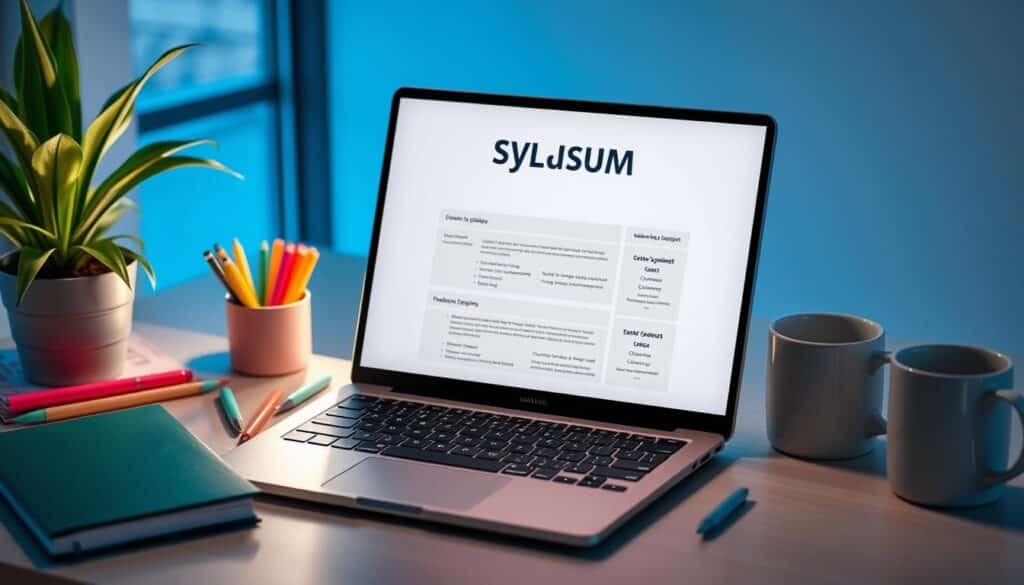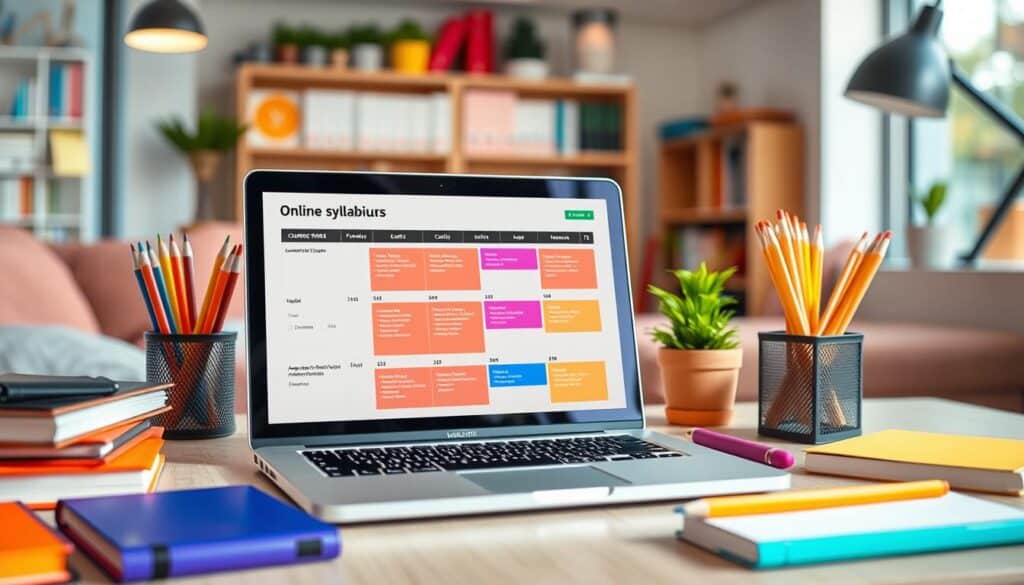In today’s world, the online syllabus is key for students. More teachers now share syllabi online instead of printing them. It’s important for students to know how an online syllabus helps them learn.
The online syllabus is like a contract, a guide, and a tool for learning. It sets up the course’s structure for success. It also shows the schedule of activities and assignments.
It outlines what students need to know before starting. It tells them what to expect and how to meet those expectations. This makes sure everyone knows what the course promises to teach.
The syllabus also gives important details and a map of the course. It shows the main ideas and topics. It sets the course’s mood, showing how the teacher views learning.
Key Takeaways
- The online syllabus serves as a contract, reference guide, and learning tool for students in the digital learning environment.
- Instructors are increasingly distributing syllabi electronically rather than handing out physical copies.
- The syllabus establishes the prerequisites, expectations, requirements, and policies for the course, guiding students’ academic success.
- The online syllabus functions as a promise, clearly articulating what students will learn and how they will fulfill that promise.
- The syllabus provides logistical and administrative information, as well as a conceptual map of the course curriculum and central themes.
What is an Online Syllabus?
An online syllabus is a detailed document that outlines an online course’s structure and expectations. It acts as a guide for students, providing key information about the course content and learning goals. The syllabus is crucial for setting the course’s tone and guiding students through their online learning journey.
Definition and Purpose
An online syllabus is essentially a contract between the instructor and students. It outlines the course’s goals, learning activities, and how students will be assessed. It also includes important details like the instructor’s contact info, course policies, and a weekly schedule. This helps students understand what’s expected and manage their time well.
The online syllabus does more than just inform students. It also serves as a permanent record for accountability and accreditation. It shows how the course content aligns with learning outcomes and assessment strategies. Moreover, it helps students manage their time in the asynchronous online environment by setting a schedule of learning activities.
| Key Components of an Online Syllabus | Purpose |
|---|---|
| Instructor information | Provides contact details and availability |
| Reading materials and supplies | Outlines required textbooks, resources, and technology |
| Policies | Communicates course expectations, grading criteria, and other guidelines |
| Class schedule | Presents the weekly topics, assignments, and due dates |
Understanding the definition and purpose of an online syllabus helps instructors create a valuable learning tool. This tool supports students on their online course journey.
Components of an Effective Online Syllabus

Making a good online syllabus is key for student success in online courses. It acts as a guide, showing what’s important for a great learning experience.
Key Elements of an Effective Online Syllabus
An effective online syllabus has several important parts:
- Clear, Measurable Learning Objectives: List what students will learn by the end of the course. This helps them know what to expect and what they’ll achieve.
- Robust Assessment and Activity Descriptions: Give full details on what students will do and how it will count towards their grade.
- Detailed Course Schedule: Show a clear plan of what topics will be covered, when, and what’s due. This helps students stay on track.
- Inviting, Approachable Tone: Use a friendly tone to motivate students and show you care about their success.
- Student Support Resources: List all the help available, like tech support, academic advice, and virtual office hours.
- Accessibility Considerations: Make the syllabus easy to read for everyone, using clear headings and descriptive links for screen readers.
By including these elements, teachers can make a syllabus that’s clear, engaging, and helps students do well online.
“The online syllabus is the foundation for a successful online course, as it establishes clear guidelines, expectations, and a roadmap for both the instructor and the students.”
Online Syllabus as a Learning Tool

The online syllabus is key as a learning tool. It’s called a Learning Focused Syllabus (LFS). This syllabus helps instructors connect with students by setting clear goals and expectations. It also outlines the course schedule and encourages student success.
By focusing on the online teaching environment, the LFS helps students stay organized. It teaches them to manage their time well and understand the course’s expectations and policies.
Studies show that learners and instructors rarely look at the syllabus after the first day. But, regular quizzes on the syllabus help learners get familiar with it. This makes them more prepared for assessments and encourages them to be independent.
Instructors can also make the syllabus a “living document” that changes as the course goes on. This is especially helpful in teaching online, online syllabus, online course syllabus online courses.
Encouraging learners to use the syllabus for answers helps them become more self-sufficient. It also serves as a guide for understanding course goals. Instructors can make the syllabus a part of daily activities to ensure everyone covers the content. This is especially important in the online learning world.
| Syllabus Utilization | Benefit |
|---|---|
| Learners and instructors seldom refer to the syllabus after the first day of class | Regular syllabus quizzes help familiarize learners with the syllabus and encourage them to revisit it throughout the semester, aiding in their autonomy and preparation for assessments |
| Instructors can create dynamic “living syllabi” that can be continuously updated | This approach helps reinforce class policies, learning outcomes, and previously covered content, particularly beneficial in online courses |
By seeing the online syllabus as a learning tool, learning experience, learning environment learning tool, instructors can improve the learning experience. This leads to better engagement, organization, and success for students in online courses.
The Importance of an Online Syllabus
An online syllabus is key for student success in college. It holds all important class details in one spot. This includes deadlines, assignments, and how to reach the professor and classmates.
By looking at the syllabus early and keeping it handy, students stay organized. They also learn how to manage their time well. This helps them understand what’s expected and the course’s rules.
This is especially true for international students. They might have many questions about U.S. classes. The online syllabus is a big help for them to do well in school.
Studies show online students do better with clear syllabi. Important announcements in red and yellow highlight key info. This includes what’s needed for the course, tech help, and how much work to expect.
Also, talking about autonomy and self-motivation in the syllabus is important. It shows students how much discipline they need to finish the course. It also makes clear who to ask for help, the teacher or tech support.
Using Facebook for office hours and questions helps students feel more connected. It makes them happier and more involved. Also, clear tech instructions in the syllabus help students use tools for the course.
Listing study tips and success strategies in the syllabus can help students do better. Having an academic integrity policy in the syllabus helps prevent cheating.
Having a grading sheet in the syllabus lets students keep track of their grades. A chapter checklist helps students manage their work. It lets them see their progress and feel a sense of achievement.
In short, the online syllabus is a vital tool for students in online courses. It gives them the info, guidance, and support they need to succeed.
Creating an Accessible Online Syllabus

When making an online syllabus, focus on making it accessible and inclusive. This way, all students can use it, including those with disabilities. It’s a great way to help everyone learn.
Using the right headings is key. Use Heading 1 for main sections and Heading 2 for subtopics. This helps students who use screen readers to find their way around.
Also, make sure your links have clear text. Don’t just show the URL. This helps everyone understand where the link goes, even if they’re using a screen reader.
For images and other visuals, add good alt text. This lets screen readers tell students with vision problems what’s in the picture.
By focusing on these points, you show you care about making learning accessible for everyone. An inclusive learning environment helps all students succeed. It’s good for everyone, not just those with disabilities.
| Accessibility Considerations | Benefits |
|---|---|
| Proper heading structure | Improved navigation for screen readers |
| Descriptive link text | Equal access to content for all students |
| Alternative text (alt text) for images | Ensures visual content is accessible |
| Adherence to color contrast guidelines | Enhances readability for all users |
By following these tips, you make your online syllabus better for everyone. It shows you’re serious about making learning accessible. And it makes sure everyone can get the course information and course description they need.
For more tips on making online syllabi and teaching online accessible, check out the NIU Center for Innovative Teaching and Learning.
Online Syllabus Best Practices

Making a good online syllabus is key for both instructors and students in online classes. To make a detailed and engaging online course syllabus, follow these tips:
- Use simple language that students can get. The syllabus should have all important info. This includes instructor contact details, office hours, required materials, course policies, and a clear schedule of assignments and assessments.
- Make the syllabus look good and easy to use. Use headings, bullet points, and other formatting. This helps students find what they need fast.
- Set a friendly and supportive tone in the syllabus. Show your love for the course. This makes the learning space welcoming for students.
- Make sure the syllabus is for everyone. Include features for different students. This might mean offering different formats or accessibility options.
- Keep the syllabus up to date. Make sure it reflects any changes in the course or institutional policies.
By sticking to these tips, instructors can make an online syllabus that clearly states what’s expected. It helps students succeed and makes learning online better.
| Best Practice | Description |
|---|---|
| Clear and concise language | Use straightforward language that is easy for students to understand, including all relevant information such as instructor contact details, required materials, and assignment/assessment schedules. |
| Visually appealing and easy to navigate | Employ headings, bullet points, and other formatting elements to make the syllabus visually engaging and easy for students to find information. |
| Positive and supportive tone | Establish a welcoming and enthusiastic tone in the syllabus to create a supportive learning environment for students. |
| Accessibility and inclusivity | Ensure the syllabus is accessible and inclusive, catering to the diverse needs of students. |
| Regular review and updates | Regularly review and update the syllabus to keep it current and relevant, reflecting any changes in the course or institutional policies. |
By following these best practices, instructors can develop an online syllabus that effectively communicates course expectations, supports student success, and enhances the overall online learning experience.
Also Read : Mastering The IELTS Syllabus: Tips For Success On The Test
“A well-crafted syllabus in an online learning environment serves as a planning tool for faculty and a contract between instructors and students.”
– Grant and Thornton (2007)
Conclusion
The online syllabus is key for student success in college. It brings together all important class details in one spot. This includes deadlines, assignments, and how grades are given.
By looking at the syllabus at the start of the semester, students can stay organized. They can also manage their time well and know what’s expected of them. This is especially helpful for international students who might not know the U.S. school system well.
Also, an online syllabus shows instructors care about all students. It helps create a welcoming learning space. It lets students see the teacher’s approach and skills, which is good for career advancement.
In summary, the online syllabus is a big help for students in college. It gives clear details on what’s expected in the course. This can lead to better grades and a more inclusive learning space.
As syllabi have grown longer, the online version has become even more important. It’s a key tool for both students and teachers.
FAQs
Q: What is an online course syllabus?
A: An online course syllabus is a document that outlines the key elements of a specific course, including course objectives, topics covered, schedule, assessment methods, and contact information for the course instructor. It serves as a roadmap for students throughout the course.
Q: Why is an effective online course syllabus important for students?
A: An effective online course syllabus provides clarity on course expectations, assessment criteria, and schedules. It helps students know what is required of them, such as assignments, participation in synchronous or asynchronous activities, and deadlines, ultimately contributing to their academic success.
Q: What should be included in a syllabus template for an online course?
A: A syllabus template for an online course should include sections like course title, instructor contact information, course description, learning objectives, weekly topics/modules, grading policy, required materials, and academic integrity information. This ensures that all important aspects are covered comprehensively.
Q: How can students retrieve their username and password for accessing the course syllabus?
A: Students can retrieve their username and password by visiting the institution’s login portal or contacting the IT support center. If they have forgotten their credentials, there is usually a password reset option available on the login page.
Q: What accommodations are typically outlined in the syllabus for an online course?
A: Accommodations in a syllabus for an online course might include provisions for students with disabilities, options for extended deadlines, and alternative methods of assessment to ensure that all students have equal opportunities to succeed.
Q: How often should students revise their understanding of the syllabus throughout the course?
A: Students are expected to revise their understanding of the syllabus regularly, especially before major assignments or exams. This helps keep them aligned with course expectations and aware of any updates that may have been communicated by the course instructor.
Q: What is the typical response time outlined in the syllabus for communication with the course instructor?
A: The typical response time for communication with the course instructor is usually specified in the syllabus. It often ranges from 24 to 48 hours for email inquiries, allowing students to know when they can expect a reply.
Q: How does the syllabus help in understanding academic dishonesty policies?
A: The syllabus outlines the institution’s policies on academic dishonesty, including definitions and consequences. This ensures students know what constitutes dishonest behavior and the importance of maintaining academic integrity throughout the course.
Q: Can the syllabus include information about both in-person and online course activities?
A: Yes, the syllabus can include information about both in-person and online course activities, especially in hybrid courses. This helps students understand how participation in various formats contributes to their final course grade.
Q: How can students reach out to the course instructor as mentioned in the syllabus?
A: Students can reach out to the course instructor via the contact information provided in the syllabus, which typically includes an email address and office hours. For urgent matters, students can also inquire about the preferred method of communication as specified in the syllabus.
